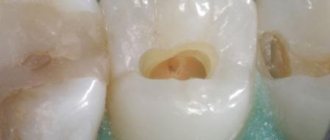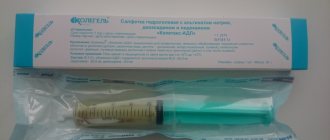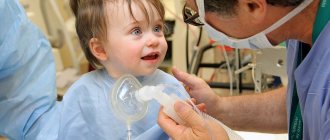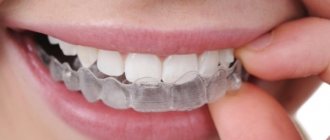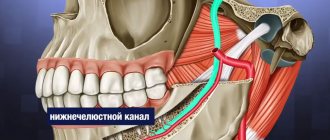We are publishing an article by Natalya Lvovna Mayorova, a dentist, therapist, and head of the therapeutic department of the Dentalika clinic.
Pain relievers used in modern dental practice can work wonders. After receiving an anesthetic injection, the patient does not feel any pain or even particularly unpleasant sensations. To ensure that the injection itself is painless, before the procedure the doctor “freezes” the injection site with a special preparation with a delicious smell of cherry, lemon, or apple.
Local anesthesia is the main method of pain relief used in dental practice. With local anesthesia, the patient remains fully conscious, and this allows the doctor to fully control the entire course of treatment, communicate with the patient, and monitor your reaction.
The quality of dental interventions depends on the results the doctor obtained during local anesthesia. Therefore, achieving 100% pain relief is necessary not only for the patient, but also for the doctor, in order to carry out treatment calmly, slowly, and efficiently. Hence the following requirements for local anesthetics:
- they must have a strong analgesic effect, easily penetrate into tissues and remain there for as long as possible;
- have low toxicity, causing a minimum number of both general and local complications
Based on these wishes, we chose several widely used drugs:
- Ultracaine DS forte (4% articaine, adrenaline 1:100,000);
- Ultracaine DS (4% articaine, adrenaline 1:200,000);
- Scandonest SVC (3% mepivacaine; without vasoconstrictors - adrenaline).
Now in more detail about their action.
General information about the drug, its composition and pharmacological properties
"Scandonest" is used in professional dental practice for the purpose of anesthetizing tissues before carrying out various medical procedures. The solution is administered by injection. It contains sodium hydroxide and chloride, saline solution, as well as the main active ingredient - mepivacaine. It is he who ensures the blocking of nerve patency, resulting in an analgesic effect. The drug is often used in patients who are hypersensitive to epinephrine.
After administration of the solution, the effect occurs after 3-4 minutes. The duration of action is approximately half an hour. After 1.5 hours, the drug is partially eliminated from the body. It should be noted that only 10% of the drug is excreted by the kidneys, and the rest of the impact is taken by the liver. Therefore, Skandanest is not recommended for liver diseases.
"Scandonest" is used in professional dental practice
Pharmacokinetics
Injected into the oral cavity through local infiltration anesthesia, mepivacaine reaches its peak concentration in the blood approximately 30 minutes after the injection. The half-life is long and is approximately 90 minutes.
Mepivacaine is metabolized quite quickly and only 5-10% is excreted unchanged in the urine. Having an amide structure, mepivacaine is not metabolized by plasma esterases. The liver is the main site of its metabolism. Any liver pathology (cirrhosis, hepatitis) leads to a general accumulation of mepivacaine.
Forms of release and estimated cost
The concentration of the active substance in the injection solution is 3%. One cartridge contains 1.8 ml, which corresponds to 54 mg of mepivacaine. The product is sold in blisters of 10 or 20 cartridges each. However, one package may contain different quantities. Approximate prices for Scandonest are shown in the table below.
| Number of cartridges | price, rub. |
| 20 | from 1500 |
| 30 | from 2200 |
| 50 | from 3800 |
| 80 | from 5900 |
| 120 | from 9 to 10 thousand |
The drug is available in cartridges
Indications and contraindications for use
This anesthetic is often used in the treatment and removal of teeth, for painless operations on the mucous membrane and jaw bone. It is used for conducting conduction, intraligamentary, intrapulpal and infiltration anesthesia in the upper and lower jaws.
Thus, among the indications for the use of Scandonest, one can highlight therapeutic treatment (filling carious cavities), treatment of fluorosis and enamel hypoplasia, nerve removal (depulpation), removal of teeth and inflamed roots, prosthetics and implantation, as well as medical procedures aimed at restoration conditions of the mucous membrane in diseases of the gums and periodontal tissues (gingivitis, periodontitis).
“When I turned 27, my last wisdom tooth came out. It grew crookedly and put pressure on the adjacent molar. It was very painful, it even began to fester. First, at my appointment, the dentist opened this abscess and told me to come back in 2 weeks. A planned removal has already been scheduled for the next appointment. I was still thinking about going under anesthesia, it was scary. But the doctor persuaded me to do simple anesthesia, scandonest. During the removal, I didn’t feel anything, although I was very tense and expected the worst. And by the way, yes, there was no such severe numbness of the tongue as had happened before. I don’t know, maybe the doctor just gave the injection correctly, or maybe it’s all thanks to this drug...”
Ruslan_88, from correspondence on the forum www.32top.ru
The drug can be used in dental treatment
. As for the restrictions on the use of the solution, experts include individual intolerance to the active substances, as well as severe systemic diseases, as absolute contraindications.
Among the relative contraindications, experts identify periods of pregnancy and lactation, problems with the liver and kidneys, disorders of the cardiovascular system, and inflammatory processes within the working area. In any case, the appropriateness of using an anesthetic remains at the discretion of the attending physician, who makes a decision based on an analysis of the individual characteristics of the body of each individual patient.
What is Adrenaline
Adrenalin is a hormone of the adrenal medulla.
It is usually obtained from the adrenal gland of cattle, and also synthetically from pyrocatechol. In addition to free adrenaline, various compounds can exist in the body.
The effect of adrenaline on the body causes reactions similar to the phenomena observed during stimulation of the sympathetic nervous system, accompanied by the release of sympathins - chemical mediators (conductors) of sympathetic nerve impulses.
Adrenaline is highly active in minute concentrations.
In medical practice, a solution of hydrochloric salt of adrenaline (Adrenalinum hydrochloricum solutum) is used in a concentration of 1: 1000.
The main pharmacological effect of adrenaline is the stimulation of the sympathetic nervous system (constriction of blood vessels in almost all areas of the body, with the exception of the vessels of the lungs, increased blood pressure, relaxation of the tone of the bronchial muscles, etc.). The use of adrenaline together with anesthetic substances in surgical practice is based on its local vasoconstrictor effect.
Adrenaline itself does not have any analgesic power, but only causes, as mentioned earlier, a narrowing of small vessels and capillaries.
It should be noted that the high concentration of adrenaline used by some practitioners for conduction and infiltration anesthesia in dental practice - 1 drop (1: 1000) per 1-2 ml of novocaine solution sometimes causes unpleasant phenomena even without the solution entering the vein: heartbeat, increased pulse rate, dizziness, fainting and sometimes even collapse. Slow injection of a fresh adrenaline solution heated to body temperature significantly reduces the toxic effect of the drug.
A weaker concentration of adrenaline during conduction and infiltration anesthesia in the dentofacial area (1 drop per 5-15 ml of solution) is less likely to cause unpleasant phenomena associated with the toxicity of the substance.
There are, however, people who are very sensitive to adrenaline and even when injecting the slightest dose of it, they react with general toxic phenomena (increased pulse, palpitations, pale face and even collapse).
Many times they tried either not to use adrenaline at all, or to replace it with less toxic substances, such as eserine, ephedrine, etc. But the elimination of adrenaline led to a decrease in the analgesic effect and to an increase in the toxicity of the anesthetic.
It should only be emphasized that for pain relief, adrenaline must be added to the anesthetic substance in the weakest concentrations. For conduction anesthesia, one drop per 5-10 ml of anesthetic solution is sufficient, and for infiltration anesthesia, one drop per 10-15 ml of solution is sufficient. When it is necessary to use a large amount of anesthetic solution, take one drop of adrenaline (1: 1000) for an even larger amount of anesthetic solution (one drop per 20-25 ml).
Instructions and recommended dosages
According to the instructions for use, the anesthetic is intended exclusively for injection. Before use, the rubber stopper and aluminum cap on the cartridge are pierced with a sterile needle, after which the solution is injected into the soft tissue within the working area. The exact dosage will depend on several factors:
- patient's age and weight,
- individual sensitivity,
- the type of anesthesia performed and the technique of its implementation,
- degree of innervation and vascularization of the area of anesthesia,
- the duration of the upcoming procedure.
The solution does not contain a vasoconstrictor to constrict blood vessels, but if it is necessary to prolong the analgesic effect, Scandonest can be administered together with adrenaline, including epinephrine, norepinephrine or methoxamine. Cholinesterases can also be administered simultaneously.
In pediatric dentistry
The drug is also suitable for use in pediatric dentistry. Since this anesthetic initially does not contain adrenaline, it can be administered to children under 5 years of age. At older ages, the use of vasoconstrictors is allowed. The dosage should be appropriate to the patient's age and actual body weight. Thus, the initial dose is usually 0.5 ml of a 3% solution, which corresponds to 0.025 ml/kg. If necessary, it can be increased to 2 ml, that is, up to 0.1 ml/kg.
The drug can be used in the treatment of children
In adult dentistry
For standard treatment procedures, 2-4 ml of solution (3%) is usually administered. The maximum permissible dose of the drug that can be administered within 2 hours for an adult patient with an approximate body weight of 75 kg is 6 ml. During the day, no more than 10 ml of solution is allowed. For elderly patients, the dosage should be reduced by half. The same applies to patients with coronary heart disease, renal and liver failure, and atherosclerosis.
Periods of pregnancy and breastfeeding
There is not yet sufficient and reliable data on the effects of the active substances of Scandonesta on the body of a pregnant woman or fetus. Therefore, as a precaution, doctors try to avoid using this anesthetic during pregnancy. The same applies to patients during lactation. If there are no other options, the drug can be used, but with extreme caution. If we are talking about lactation, the patient will be advised to stop feeding for 10 hours after the administration of anesthesia.
Use during pregnancy has not been sufficiently studied
Analogs
Ubistezin
Espe Dental AG, Germany
Price from 1420 to 2100 rubles.
A drug that is used for local anesthesia; its trade name does not coincide with the name of the active substances (epinephrine, articaine). It is used in public clinics and private clinics during various dental procedures. Ubistezin is available in the form of a solution.
Pros:
- Quick analgesic effect (for toothache)
- Can be used during pregnancy
- Characterized by low systemic toxicity.
Minuses:
- Can only be purchased with a prescription
- Should not be combined with tricyclic antidepressants
- After the injection, the occurrence of local edema cannot be ruled out.
Ultracaine D-S
Sanofi Aventis, France
Price from 506 to 5336 rubles.
A product for local anesthesia without adrenaline (adrenaline) and ananephrine. The active ingredients are articaine with epinephrine. Characterized by the same action as Ubistezin. Ultracain is available in the form of an injection solution.
Pros:
- Widely used in dentistry
- Used during lactation
- Rarely causes side effects (according to numerous reviews).
Minuses:
- You can buy drugs only with a prescription
- Contraindicated in bronchial asthma
- High price.
Possible side effects
Like any other medicine, in some cases Scandonest can provoke the development of adverse reactions. True, such troubles happen extremely rarely with this drug. Among the possible undesirable effects, experts identify the following conditions:
- from the central nervous system: impaired motor skills, lethargy, drowsiness, partial loss of tactile sensations, headache and dizziness, increased nervous excitement, anxiety, tremor and loss of consciousness,
- from the cardiovascular system: tachycardia, arrhythmia, bradycardia, low blood pressure, pain in the chest.
Side effects may include headache and dizziness.
There is a small chance of nausea and vomiting, urinary and fecal incontinence, and respiratory depression. An allergic reaction usually manifests itself as hives, itching and swelling at the injection site1. After administering the solution, the patient may feel numbness at the injection site, as well as on the tongue and lips.
It should also be taken into account that the drug inhibits motor functions, so immediately after its use it is not recommended to drive or start working with potentially dangerous equipment.
How does Scandonest interact with other medications?
To avoid an additive effect, the anesthetic should not be used in combination with a number of other medications. This category of drugs includes sedatives and antihistamines, as well as antiarrhythmic drugs that help reduce the frequency of contractions and myocardial conductivity.
The anesthetic should not be combined with certain drugs
Anesthetics with similar effects
Analogs of Scandonest include anesthetics based on mepivacaine or other active ingredients. Among the anesthetic drugs in demand today, experts highlight the following injection solutions:
- Mepivastezin is based on the same active substance, so the indications for its use are identical to Scandonest. Allowed for use by children aged 4 years and older. Has additional immunomodulatory effects. Not recommended for patients with kidney and liver diseases, as well as pregnant women and during breastfeeding,
- "Ultracaine" is an anesthetic based on articaine, used for infiltration and conduction anesthesia. One of the most effective drugs from its group. Approved for use in children over 4 years of age,
- "Mepidont" is an anesthetic based on mepivacaine containing the vasoconstrictor epinephrine,
- "Scandinibsa" is a solution with mepivacaine as the main active ingredient. Allowed for children over 4 years of age, patients with diabetes, hypertension, heart failure and thyrotoxicosis. Suitable for patients with hypersensitivity to adrenaline.
Scandonest is a new generation of painkillers. The composition does not contain adrenaline, which has significantly expanded the range of its use. Like other modern solutions for local anesthesia, for example, based on articaine, this drug has proven itself to be an effective and safe anesthetic.
1Malamed S.F. Allergic and toxic reactions to local anesthetics, 2004.
Failed anesthesia
I would also like to touch upon the topic of unsuccessful local anesthesia. Almost every dentist has encountered this in their practice. The reasons for this phenomenon can be classified into 2 groups:
- depending on the doctor (poor choice of anesthesia technique and anesthetic solution; errors in the technique);
- depending on the anatomical and psychological characteristics of the patient.
To eliminate psychological causes in patients with a labile psyche (with increased emotionality, sensitivity, excitability), premedication is used: sedatives and sedatives.
In all other cases, the doctor must approach the choice of anesthetic and local anesthesia technique with even greater responsibility and professionalism, starting from the very first minutes of communication with the patient (history collection).
You should always remember that there are NO teeth that cannot be anesthetized, it’s just sometimes more difficult to achieve this.
High-quality pain relief minimizes patient discomfort and allows dentists to perform the necessary interventions.
Natalya Lvovna Mayorova doctor - therapist - dentist October 2009
Dear Colleagues! When copying information, placing a link to the source site is mandatory.

